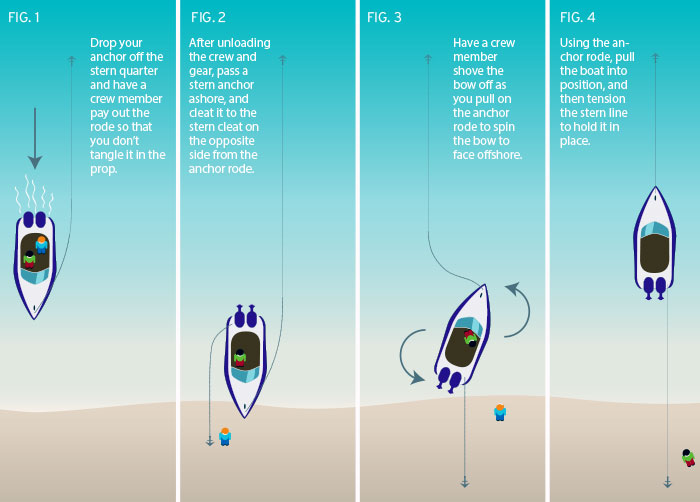Advertisement
So you want to beach your boat and leave again, unscathed? Here is a useful technique for small- and medium-size powerboats.
Nothing beats a day at the beach — except perhaps a day at the beach when you arrive by boat. So it's understandable that many boat owners beach their boat when it's time to go swimming. But while driving the boat into shore with the outboard or sterndrive trimmed up is the simplest approach, leaving your boat bow to shore presents drawbacks.
Tip
Never back toward the beach! It's dangerous to swimmers and far too easy to bump bottom, damaging the prop and/or sucking sand through the cooling system.
First, it's easy to get stuck. A falling tide, wind, or waves pushing onshore — or even a large wake from a passing boat — can easily leave you high and dry, and a quick survey of Internet boating forums shows that's a common occurrence.
Second, even if that passing wake doesn't push the boat ashore, it can swamp the boat, riding up and over the transom, which — depending on how far up the beach you left your boat — may be lower in the water than usual. Even if you deploy a stern anchor to keep the boat from being pushed out of position, you can't eliminate the possibility of stranding or swamping.
It takes a bit more effort, but anchoring your boat just off the beach, bow out, can prevent these problems and offer easier access to and from the boat via the stern. Follow these steps:

1. Remove your anchor from the bow locker and carry it to the stern of the boat, making sure you pass the rode outside the stanchions and under the bow rail before heading to the back of the boat. Keep the other end of the rode attached to the boat.
2. You'll want to set your anchor with enough scope to hold, but not so much that the boat swings into very shallow water. It may take a few tries to find the sweet spot at a particular beach.
3. With the engine in neutral, have a crew member lower the anchor over the side at the stern. When it has touched bottom, motor extremely slowly toward the beach as your crew pays the anchor rode out carefully, keeping it away from the prop(s). (See Figure 1.)
4. Continue very slowly into shore as you would normally, cutting the engine and trimming up in plenty of time before the bow nuzzles gently into the sand, where you'll stay temporarily. (See Figure 2.)
5. Unload your crew and gear over the bow. This includes a second stern anchor or sand spike for the beach and line. After securing that second line to an aft cleat, have a crew member walk that second anchor (or spike) toward the beach and set it securely.
6. With your crew ashore and the engine(s) remaining trimmed up, pull the boat back into deeper water using the bow anchor rode until you're satisfied that the stern is well clear of the bottom. (It may help to get a little shove off the sand from someone ashore.) If using a stern anchor, be sure the line is flaked out to run free. (See Figure 3.)
7. When you're a short distance off the beach, snub off your anchor rode at the bow, and pull your stern line so that you get enough tension to hold the boat in place. I like the water to be at least waist deep at the stern. That way, when I put out the boarding ladder, I don't have to worry about it striking bottom if a big wake comes ashore. (See Figure 4.)
8. When it's time to leave, go out to the boat, climb aboard, pay out a little more scope on the bow anchor rode, pull in some of the stern anchor rode, then have the rest of your crew wade out to the boat and climb aboard. One of your crew can pick up the stern anchor or spike. Next, bring all the stern rode back into the boat and make sure it's coiled and secured in the cockpit. Don't forget to pull up the boarding ladder. Then, with your bow anchor rode, pull the boat back to deeper water until it's safe to lower your engines and fire them up. With the engines in neutral or in idle forward, if needed, pull in the rode and bow anchor, and you're away.
